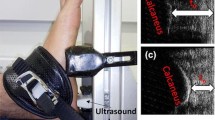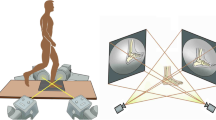Abstract
Mechanical behaviour of the heel pad, as a shock attenuating interface during a foot strike, determines the loading on the musculoskeletal system during walking. The mathematical models that describe the force deformation relationship of the heel pad structure can determine the mechanical behaviour of heel pad under load. Hence, the purpose of this study was to propose a method of quantifying the heel pad stress–strain relationship using force–deformation data from an indentation test. The energy input and energy returned densities were calculated by numerically integrating the area below the stress–strain curve during loading and unloading, respectively. Elastic energy and energy absorbed densities were calculated as the sum of and the difference between energy input and energy returned densities, respectively. By fitting the energy function, derived from a nonlinear viscoelastic model, to the energy density–strain data, the elastic and viscous model parameters were quantified. The viscous and elastic exponent model parameters were significantly correlated with maximum strain, indicating the need to perform indentation tests at realistic maximum strains relevant to walking. The proposed method showed to be able to differentiate between the elastic and viscous components of the heel pad response to loading and to allow quantifying the corresponding stress–strain model parameters.




Similar content being viewed by others
References
Aerts P, De Clercq D (1993) Deformation characteristics of the heel region of the shod foot during a simulated heel strike: the effect of varying midsole hardness. J Sports Sci 11:449–461. doi:10.1080/02640419308730011
Aerts P, Ker RF, De Clercq D et al (1995) The mechanical properties of the human heel pad: a paradox resolved. J Biomech 28:1299–1308
Aerts P, Ker RF, de Clercq D, Ilsley DW (1996) The effects of isolation on the mechanics of the human heel pad. J Anat 188(Pt 2):417–423
Bennett MB, Ker RF (1990) The mechanical properties of the human subcalcaneal fat pad in compression. J Anat 171:131–138
Challis JH, Murdoch C, Winter SL (2008) Mechanical properties of the human heel pad: a comparison between populations. J Appl Biomech 24:377–381
Chao CYL, Zheng Y-P, Huang Y-P, Cheing GL-Y (2010) Biomechanical properties of the forefoot plantar soft tissue as measured by an optical coherence tomography-based air-jet indentation system and tissue ultrasound palpation system. Clin Biomech (Bristol, Avon) 25:594–600. doi:10.1016/j.clinbiomech.2010.03.008
Chatzistergos PE, Naemi R, Sundar L et al (2014) The relationship between the mechanical properties of heel-pad and common clinical measures associated with foot ulcers in patients with diabetes. J Diabet Complicat 28:488–493
Cole GK, Nigg BM, van Den Bogert AJ, Gerritsen KGM (1996) The clinical biomechanics award paper 1995 Lower extremity joint loading during impact in running. Clin Biomech (Bristol, Avon) 11:181–193
Erdemir A, Viveiros ML, Ulbrecht JS, Cavanagh PR (2006) An inverse finite-element model of heel-pad indentation. J Biomech 39:1279–1286. doi:10.1016/j.jbiomech.2005.03.007
Gefen A (2003) Plantar soft tissue loading under the medial metatarsals in the standing diabetic foot. Med Eng Phys 25:491–499. doi:10.1016/S1350-4533(03)00029-8
Gefen A, Megido-Ravid M, Itzchak Y (2001) In vivo biomechanical behavior of the human heel pad during the stance phase of gait. J Biomech 34:1661–1665
Gerritsen KG, van den Bogert AJ, Nigg BM (1995) Direct dynamics simulation of the impact phase in heel-toe running. J Biomech 28:661–668
Gilchrist LA, Winter DA (1996) A two-part, viscoelastic foot model for use in gait simulations. J Biomech 29:795–798
Gilchrist LA, Winter DA (1997) A multisegment computer simulation of normal human gait. IEEE Trans Rehabil Eng 5:290–299
Hsu TC, Wang CL, Shau YW et al (2000) Altered heel-pad mechanical properties in patients with Type 2 diabetes mellitus. Diabet Med 17:854–859
Hsu T, Lee Y, Shau Y (2002) Biomechanics of the heel pad for type 2 diabetic patients. Clin Biomech 17:291–296
Hsu C-C, Tsai W-C, Shau Y-W et al (2007) Altered energy dissipation ratio of the plantar soft tissues under the metatarsal heads in patients with type 2 diabetes mellitus: a pilot study. Clin Biomech (Bristol, Avon) 22:67–73. doi:10.1016/j.clinbiomech.2006.06.009
Hsu C-C, Tsai W-C, Hsiao T-Y et al (2009) Diabetic effects on microchambers and macrochambers tissue properties in human heel pads. Clin Biomech (Bristol, Avon) 24:682–686. doi:10.1016/j.clinbiomech.2009.06.005
Jahss MH, Michelson JD, Desai P et al (1992) Investigations into the fat pads of the sole of the foot: anatomy and histology. Foot Ankle 13:233–242
Jørgensen U, Bojsen-Møller F (1989) Shock absorbency of factors in the shoe/heel interaction—with special focus on role of the heel pad. Foot Ankle 9:294–299
Ledoux WR, Blevins JJ (2007) The compressive material properties of the plantar soft tissue. J Biomech 40:2975–2981. doi:10.1016/j.jbiomech.2007.02.009
Miller RH, Hamill J (2009) Computer simulation of the effects of shoe cushioning on internal and external loading during running impacts. Comput Methods Biomech Biomed Engin 12:481–490. doi:10.1080/10255840802695437
Miller-Young JE, Duncan NA, Baroud G (2002) Material properties of the human calcaneal fat pad in compression: experiment and theory. J Biomech 35:1523–1531
Mullins L (1948) Effect of stretching on the properties of rubber. Rubber Chem Technol 21:281–300. doi:10.5254/1.3546914
Naemi R, Chockalingam N (2013) Mathematical models to assess foot-ground interaction: an overview. Med Sci Sports Exerc 45:1524–1533. doi:10.1249/MSS.0b013e31828be3a7
Natali N, Fontanella CG, Carniel EL (2010) Constitutive formulation and analysis of heel pad tissues mechanics. Med Eng Phys 32:516–522. doi:10.1016/j.medengphy.2010.02.018
Natali N, Fontanella CG, Carniel EL, Young JM (2011) Biomechanical behaviour of heel pad tissue experimental testing, constitutive formulation, and numerical modelling. Proc Inst Mech Eng Part H J Eng Med 225:449–459. doi:10.1177/09544119JEIM851
Pai S, Ledoux WR (2010) The effect of target strain error on plantar tissue stress. J Biomech Eng 132:071001. doi:10.1115/1.4001398
Pai S, Ledoux WR (2011) The quasi-linear viscoelastic properties of diabetic and non-diabetic plantar soft tissue. Ann Biomed Eng 39:1517–1527. doi:10.1007/s10439-011-0263-z
Peña E, Peña J, Doblaré M (2009) On the Mullins effect and hysteresis of fibered biological materials: a comparison between continuous and discontinuous damage models. Int J Solids Struct 46:1727–1735
Rome K, Webb P, Unsworth A, Haslock I (2001) Heel pad stiffness in runners with plantar heel pain. Clin Biomech (Bristol, Avon) 16:901–905
Scott SH, Winter DA (1993) Biomechanical model of the human foot: kinematics and kinetics during the stance phase of walking. J Biomech 26:1091–1104
Tong J, Lim C, Goh O (2003) Technique to study the biomechanical properties of the human calcaneal heel pad. Foot 13:83–91. doi:10.1016/S0958-2592(02)00149-9
Wearing SC, Smeathers JE, Yates B et al (2009) Bulk compressive properties of the heel fat pad during walking: a pilot investigation in plantar heel pain. Clin Biomech (Bristol, Avon) 24:397–402. doi:10.1016/j.clinbiomech.2009.01.002
Whittle MW (1999) Generation and attenuation of transient impulsive forces beneath the foot: a review. Gait Posture 10:264–275
Zheng YP, Choi YK, Wong K et al (2000) Biomechanical assessment of plantar foot tissue in diabetic patients using an ultrasound indentation system. Ultrasound Med Biol 26:451–456
Acknowledgments
This work was supported by the Directorate-General for Research and Innovation (EC) through DiabSmart project, which was funded under Industry Academia Partnerships and Pathways Programme (FP7-PEOPLE-2011-IAPP, GA 285985).
Author information
Authors and Affiliations
Corresponding author
Rights and permissions
About this article
Cite this article
Naemi, R., Chatzistergos, P.E. & Chockalingam, N. A mathematical method for quantifying in vivo mechanical behaviour of heel pad under dynamic load. Med Biol Eng Comput 54, 341–350 (2016). https://doi.org/10.1007/s11517-015-1316-5
Received:
Accepted:
Published:
Issue Date:
DOI: https://doi.org/10.1007/s11517-015-1316-5




